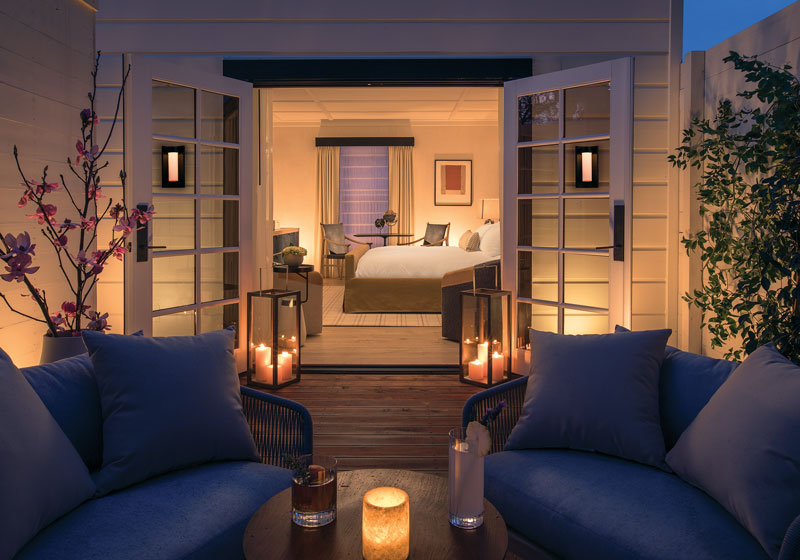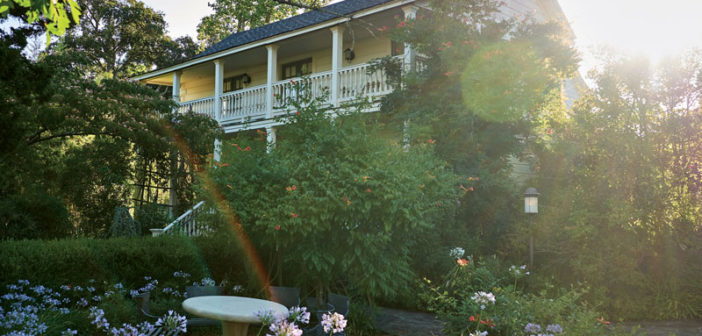Celebrating its historic 150th anniversary, MacArthur Place Hotel & Spa is embracing its farmhouse charm, debuting its $20-million redesign. The project touched nearly all parts of the property from its 64 guestrooms and public spaces to its pool and spa—and even includes reimagined dining outlets.
Led by RDC Architecture and SFA Design, the renovation incorporated the property’s natural surroundings and history.
“Properties like MacArthur Place are unique and rare in Sonoma Valley,” said Michael Ross, principal, RDC Architecture. “Larger naturalistic estates like this are the memory of working farmsteads, which used to be common in the Valley—only a few still exist. MacArthur Place is an ensemble of historic and current buildings that are generously separated by open space, light, air and gardens. My primary inspiration was to enhance one of the property’s most compelling aspects—evoking clustered farm buildings in a garden landscape. My ambition for the architectural design was to reflect the past, update the facilities to contemporary hospitality standards and seamlessly integrate the buildings into a garden setting.”
The idea was to transport guests into the heart of Sonoma from the moment they arrive, Ross said, informing them about its past and inspiring them at every turn. Because of the building’s history—it’s a 100-plus-year-old family estate, vineyard and working ranch—not much had to be done to its exterior.
At the front of the property is the Burris House—the private estate of miner, rancher and founder of Sonoma’s first bank, David Burris, built in 1869—which informed a lot of the design. In 1997, the manor house was converted into a country inn.
 “The structure is a true representation of the Victorian farmhouse era architecture that Sonoma is known for,” said Justin Bain, director of marketing/brand management of owner and management company IMH Hospitality. “The interiors offer our own modern take on farmhouse design. We used many accents, such as sliding farm doors, white oak hardwood floors, hand-painted tiles and rough-hewn beams, which are all indicative of Sonoma’s past and present.”
“The structure is a true representation of the Victorian farmhouse era architecture that Sonoma is known for,” said Justin Bain, director of marketing/brand management of owner and management company IMH Hospitality. “The interiors offer our own modern take on farmhouse design. We used many accents, such as sliding farm doors, white oak hardwood floors, hand-painted tiles and rough-hewn beams, which are all indicative of Sonoma’s past and present.”
The building’s white picket fence was preserved and still stands today, but the design team was also focused on breathing new life into the space.
“The MacArthur Place of today is a completely new experience, inspired by and connected to the historic pedigree, natural bounty and physical beauty of MacArthur Place and Sonoma. Every moment, material and touchpoint…brings a fresh, elevated spin on classic farmhouse style to Sonoma,” Bain said.
Other nods to its farmhouse roots are in the lobby, formerly the meeting rooms of the old “Barn,” which is now adorned with oak wood floors, millwork and blackened steel accents.
“The focal point of the high-ceilinged space is a forged iron chandelier inspired by the spokes of a wagon wheel. This could often be found among the old Burris Estate and is a subtle nod to the history of the property as a working horse ranch that trained trotters used for transportation in this horse-and-buggy era,” Ross said.
Custom-designed millwork also makes its way into the guest bathrooms with neutral limestone vanities and travertine floors. “Select guestrooms play host to refurbished wood-burning fireplaces—a classic and quintessential farmhouse detail,” Ross said.
Adjacent to the Barn is the Coach House, which has three distinct meeting/event rooms. Also for events is the West Lawn, mainly for wedding ceremonies. It will be re-seeded and enhanced with a new wedding trellis/pavilion. The pool and spa are still in concept phase, with development expected to begin this winter.
What is up and running, though, is the reimagined dining venue, Layla, a Mediterranean-inspired restaurant.
“The use of textures, such as faux concrete tabletops, custom wicker pendants, sconces made of rope, glass and steel, all reinforce the casual yet sophisticated feel,” said Kara Smith, president, SFA Design. “The custom banquettes and booths, composed of wood and upholstery, use plaids, stripes and leather to further embellish the space and add another layer of texture and pattern in juxtaposition with the white walls.”
 Layla also has an outdoor deck for alfresco dining and lights scattered throughout Chinese Pistache trees.
Layla also has an outdoor deck for alfresco dining and lights scattered throughout Chinese Pistache trees.
There’s also the Bar at MacArthur, which blends the new and old through its copper bar face and wood top, juxtaposed by rich oakwood floors, polished plaster walls in dark green, with accents of teal, persimmon and green, and roughhewn beams overhead, Smith said. The SFA design team also incorporated works from local vendors into the space like vintage rugs and custom light fixtures.
Keeping the antique appeal was important for the design team throughout the process, and in all aspects of the space, as it provided the foundation for the design.
“To balance the feel of a luxury hotel with the farmhouse charm Sonoma is known for, we kept traditional facets, such as the dark wood sliding barn doors, and added new ones like the stone inlay fireplace in the guestrooms. Our approach was to keep the iconic and historical influence that was the basis of the property; we then accented it with modern yet cozy elements,” Smith said.
Part of the renovation was also weaving in aspects of the local community. A pedestrian gate was added to the entrance of the Burris House to foster connection.
“Originally the path of travel to the historic property was screened from view from the street by dense landscape plantings. We carefully altered the landscaping…creating views to the historic Burris House,” Ross said.
Opening its doors to locals was also one of the driving forces behind The Porch, a coffee bar and marketplace.
“It’s for locals to grab a bite, and it’s also a gathering spot with patio seating,” Bain noted. The space features screen-printed ceramic tiles from artist Marianne Smink of Smink Things, vintage-inspired brass lighting fixtures and large, mirrored hand-painted menus for added interior charm.
“The design solution needed to be fresh, timeless and natural,” Ross said. “We believe the final [product]poetically weaves these attributes into the garden hotel experience.” HB


